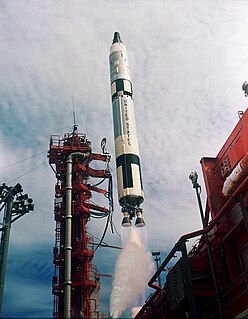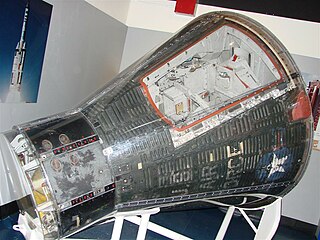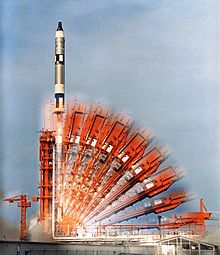
Vandenberg Air Force Base is a United States Air Force Base located 9.2 miles (14.8 km) northwest of Lompoc, California. The installation falls under the jurisdiction of the 30th Space Wing, Air Force Space Command (AFSPC).

The Martin Marietta SM-68A/HGM-25A Titan I was the United States' first multistage intercontinental ballistic missile (ICBM), in use from 1959 until 1962. Though the SM-68A was operational for only three years, it spawned numerous follow-on models that were a part of the US arsenal and space launch capability. The Titan I was unique among the Titan models in that it used liquid oxygen and RP-1 as propellants. All subsequent versions used storable propellants instead.

The PGM-11 Redstone was the first large American ballistic missile. A short-range ballistic missile (SRBM), it was in active service with the United States Army in West Germany from June 1958 to June 1964 as part of NATO's Cold War defense of Western Europe. It was the first US missile to carry a live nuclear warhead, in the 1958 Pacific Ocean weapons test, Hardtack Teak. Chief Engineer Wernher von Braun personally witnessed this historic launch and detonation.

The RM-81 Agena was an American rocket upper stage and satellite bus which was developed by Lockheed initially for the canceled WS-117L reconnaissance satellite program. Following the split-up of WS-117L into SAMOS and Corona for image intelligence, and MIDAS for early warning, the Agena was later used as an upper stage, and an integrated component, for several programs, including Corona reconnaissance satellites and the Agena Target Vehicle used to demonstrate rendezvous and docking during Project Gemini. It was used as an upper stage on the Atlas, Thor, Thorad and Titan IIIB rockets, and considered for others including the Space Shuttle and Atlas V. A total of 365 Agena rockets were launched between February 28, 1959 and February 1987. Only 33 Agenas carried NASA payloads and the vast majority were for DoD programs.

Cape Canaveral Air Force Station (CCAFS) is an installation of the United States Air Force Space Command's 45th Space Wing.

Gemini 1 was the first mission in NASA's Gemini program. An uncrewed test flight of the Gemini spacecraft, its main objectives were to test the structural integrity of the new spacecraft and modified Titan II launch vehicle. It was also the first test of the new tracking and communication systems for the Gemini program and provided training for the ground support crews for the first manned missions.

Gemini 2 was the second spaceflight of the American human spaceflight program Project Gemini, and was launched and recovered on January 19, 1965. Gemini 2, like Gemini 1, was an unmanned mission intended as a test flight of the Gemini spacecraft. Unlike Gemini 1, which was placed into orbit, Gemini 2 made a suborbital flight, primarily intended to test the spacecraft's heat shield. It was launched on a Titan II GLV rocket. The spacecraft used for the Gemini 2 mission was later refurbished into the Gemini B configuration, and was subsequently launched on another suborbital flight, along with OPS 0855, as a test for the US Air Force Manned Orbital Laboratory. Gemini spacecraft no. 2 was the first craft to make more than one spaceflight since the X-15, and the only one until Space Shuttle Columbia flew its second mission in 1981.

The Manned Orbiting Laboratory (MOL), originally referred to as the Manned Orbital Laboratory, was a never-flown part of the United States Air Force's human spaceflight program, a successor to the cancelled Boeing X-20 Dyna-Soar military reconnaissance space plane project. The project was developed from several early Air Force and NASA concepts of crewed space stations to be used for reconnaissance purposes. MOL evolved into a single-use laboratory, with which crews would be launched on 40-day missions and return to Earth using a Gemini B spacecraft, derived from NASA's Project Gemini.

The Titan II was an intercontinental ballistic missile (ICBM) and space launcher developed by the Glenn L. Martin Company from the earlier Titan I missile. Titan II was originally designed and used as an ICBM, but was later adapted as a medium-lift space launch vehicle to carry payloads to Earth orbit for the United States Air Force (USAF), National Aeronautics and Space Administration (NASA) and National Oceanic and Atmospheric Administration (NOAA). Those payloads included the USAF Defense Meteorological Satellite Program (DMSP), NOAA weather satellites, and NASA's Gemini crewed space capsules. The modified Titan II SLVs were launched from Vandenberg Air Force Base, California, up until 2003.

Project Gemini was NASA's second human spaceflight program. Conducted between projects Mercury and Apollo, Gemini started in 1961 and concluded in 1966. The Gemini spacecraft carried a two-astronaut crew. Ten Gemini crews flew low Earth orbit (LEO) missions during 1965 and 1966, putting the United States in the lead during the Cold War Space Race against the Soviet Union.

Launch Complex 14 (LC-14) is a launch site at Cape Canaveral Air Force Station in Florida. LC-14 was used for various manned and unmanned Atlas launches, including the Friendship 7 flight aboard which John Glenn became the first American to orbit the Earth.

Launch Complex 5 (LC-5) was a launch site at Cape Canaveral Air Force Station, Florida used for various Redstone and Jupiter launches.

The Air Force Space and Missile Museum is located at Launch Complex 26 at Cape Canaveral Air Force Station, Florida. It includes artifacts from the early American space program and includes an outdoor rocket garden displaying rockets, missiles and space-related equipment chronicling the US Air Force.
The SM-68 Titan was the designation of two intercontinental ballistic missiles developed for the United States Air Force. The Titan I and Titan II missiles were operational between 1962 and 1987 during the Cold War. These missiles, particularly the Titan II, were the basis of the Titan family of space launch vehicles.
Launch Complex 15 (LC-15) at Cape Canaveral Air Force Station, Florida is a deactivated launch complex used by LGM-25 Titan missiles between 1959 and 1964. It was originally built for conducting test flights of the Titan I, which made its maiden flight from LC-15 on 6 February 1959. LC-15 is the southernmost of the four original Titan launch complexes on Missile Row.

Launch Complex 16 (LC-16) at Cape Canaveral Air Force Station, Florida is a launch complex built for use by LGM-25 Titan missiles, and later used for NASA operations before being transferred back to the US military and used for tests of MGM-31 Pershing missiles. Six Titan I missiles were launched from the complex between December 1959 and May 1960. These were followed by seven Titan II missiles, starting with the type's maiden flight on March 16, 1962. The last Titan II launch from LC-16 was conducted on May 29, 1963.

The Titan II GLV or Gemini-Titan II was an American expendable launch system derived from the Titan II missile, which was used to launch twelve Gemini missions for NASA between 1964 and 1966. Two uncrewed launches followed by ten crewed ones were conducted from Launch Complex 19 at the Cape Canaveral Air Force Station, starting with Gemini 1 on April 8, 1964.

The 6555th Aerospace Test Group is an inactive United States Air Force unit. It was last assigned to the Eastern Space and Missile Center and stationed at Patrick AFB, Florida. It was inactivated on 1 October 1990.

Gemini spacecraft No. 2 was the second NASA Project Gemini full-up space capsule built. This McDonnell Gemini capsule was the first spacecraft to be reused, flying twice into suborbital space. No.2 flew on missions Gemini-Titan 2 and Manned Orbiting Laboratory Gemini-B flight. The capsule is currently on display at the Smithsonian Institution, in Washington, D.C..























